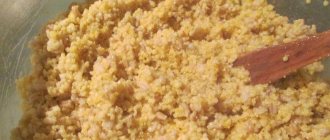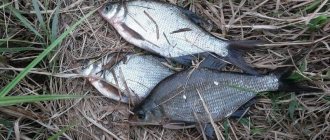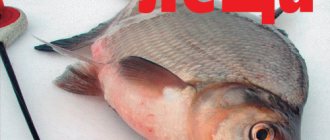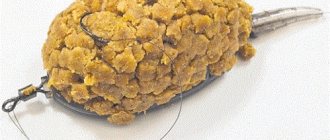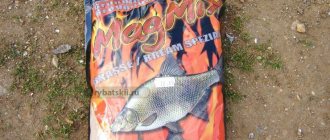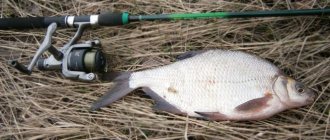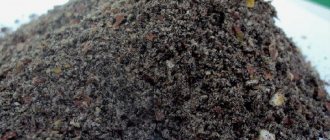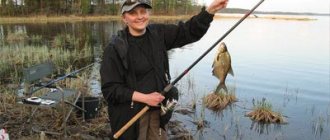In the vastness of our Motherland, bream and bream are one of the most beloved trophies in fishing. However, it can be quite difficult to understand where the school is now. Therefore, one of the main components of success is bait, which can lure the future catch at a great distance.
Bream porridge recipes vary depending on the time of year and the type of reservoir . There is no universal option that would always work, so preparation for fishing must be thorough. You can use store-bought formulas or prepare complementary foods yourself; everyone makes their own choice, depending on the desired result.
Store-bought mixtures or homemade bait?
Today there is a fairly large number of ready-made mixtures for preparing porridge on the market, and many manufacturers show really good results.
The store-bought dry mix option is more suitable for beginners or people who go fishing extremely rarely with the goal of relaxing rather than coming home with a good catch.
Experienced fishermen always prepare complementary foods themselves. After all, this is the only way to be sure of the components and select the composition for a specific body of water. Bream is a harmful fish, so the same porridge on neighboring lakes can work very differently.
The finished product must meet the following set of criteria:
- unfamiliar ingredients in the porridge will scare away bream , so for cooking it is better to use simple and familiar ingredients;
- attractants and flavoring agents are responsible for attracting from long distances, so the food should be not only tasty, but also aromatic;
- a large number of small (dust) ingredients will lead to the appearance of small things that will scare away large individuals;
- The composition after mixing must be mixed very thoroughly . If the complementary food contains a lot of lumps, then the fish will quickly become full and lose interest in the food offered on the hook. After all, the main goal is to catch, not feed, bream, right?
As you can see, there are quite a lot of requirements for porridge, and it is only possible to understand whether purchased options meet them in practice, and you will have to pay a decent amount for a box. Therefore, many of our compatriots prefer to spend some time in the kitchen before fishing rather than trust industrial designs.
How to properly cook peas for feeder bait
The porridge should sit for 4-5 hours. After this, you need to add the previously prepared peas and we can say that the porridge in its basic version is ready. We received large fractions in the form of peas and pearl barley, as well as nutritious and high-calorie millet. Large fractions will keep the fish in one place.
When fishing, you should add crackers or makuha. The crackers will make the bait dusty, and the dust will add an aroma that attracts crucian carp. You can add 0.5 kg of crackers per 3 kg of the finished mixture. A very important point is the friability of homemade bait. It should wash out within 5 minutes.
When fishing, you can inject sprays with different flavors into the bait. Before each cast, you can spray dips and sprays directly onto the feeder.
And here's what you need to know: Donka for bream
Author-Dmukhovsky Ruslan Yaroslavovich, Ukraine, Krivoy Rog-Especially for Homemade Fish
Components of bait
Porridge recipes may differ from each other, but the main ingredients are always the same - these are products that have always been loved by bream.
The main ingredients of good complementary foods:
- cake Not the most expensive, but absolutely indispensable product for fishing. Finely ground rapeseed, pumpkin and hemp seeds are used. But the most common option is sunflower, or rather its seeds;
- breadcrumbs. Dried white or rye bread is used. They differ in color and are used depending on the color of the bottom. Bream will not accept complementary food that is radically different in color from the surface, no matter how fragrant it is;
- bran. Used only in standing water as a leavening agent;
- connecting elements. Most often used: ground peas;
- ordinary clay;
- Wheat flour;
There are secret components that fishermen pass on from mouth to mouth, but they are not always used, and it is almost impossible to systematize them. For a good result, the components presented above will be sufficient.
Cooking porridge from peas and millet
Dough is also used as a nozzle, but prepared in a special way and with additives. Moreover, the dough is made both traditionally, from wheat flour, and, for example, from steamed peas with the addition of flour and oatmeal.
- Brew wheat flour in boiling water;
- add semolina or cookies;
- knead the dough so that it does not stick to your hands;
- tie it in a gauze bag and place it in boiling water for a few minutes.
- knead wheat flour into a stiff dough;
- knead the dough ball under running cold water for 15–20 minutes until all the dirt is washed out of it;
- add hemp or linseed oil and knead again.
And here's what you need to know: Running self-cutting equipment. How to catch carp? || Self-cutting bottom tackle
Recipe 3. Pea dough:
- Mix ½ cup of boiled peas with ½ cup of steamed oatmeal and a tablespoon of flour;
- knead the dough, make a ton of cake and fry it in vegetable oil;
- knead the resulting pancake with your hands and fry again.
- repeat this several times.
- Calm fish, such as roach, crucian carp or tench, bite well on the dough.
- The dough can be kneaded not with water, but with milk, dry baby formula, and even berry juice. A supplement in the form of a raw egg wouldn't hurt either.
- When kneading the dough, it is useful to add cotton wool, then it will stick better to the hook.
- Bleak likes to peck on the dough, and this interferes with catching large fish. To scare away small things, it is recommended to tint the dough, make it darker, since bleak prefers light bait.
Making your own bait
Here are several popular recipes that will help you properly feed bream at different times of the year and in different bodies of water.
Recipe No. 1. Summer, closed reservoir without current
For such conditions the following composition is suitable:
- 300 grams of breadcrumbs;
- ground (makukha) or roasted sunflower seeds – 0.2 kilograms;
- bran and boiled millet – 300 grams of each product;
- dry crushed coriander - about two-thirds of a teaspoon;
- dry crushed clay. It is better to prepare more of it and gradually add it while wetting to achieve the desired consistency of the composition.
Recipe No. 2. Summer, fishing on a river with a pronounced current
In this case, the porridge will have slightly different ingredients:
- Sunflower cake – 0.2 kilograms;
- breadcrumbs (or ground yourself) – 100 grams;
- sprouted green peas (if it’s difficult to get them, you can use fresh ones) – 200 grams;
- steamed oatmeal – 0.2 kilograms;
- 3 teaspoons ground coriander;
- standard packet of vanilla sugar;
- fine clay or soil of the same consistency directly from the fishing spot.
Recipe No. 3. Spring
At this time of year, it is imperative to include ingredients of animal origin.
One of the popular options:
- boiled millet – 100 grams;
- sunflower cake – 100 grams;
- bran (it is advisable to find rye bran) – 100 grams;
- bloodworm - about three matchboxes;
- clay , can be mixed with sand if the bottom of the reservoir has a sandy base. If there is a thick layer of silt, it is better to add soil from the shore.
Recipe No. 4. Autumn, pond with current
During this period, the fish fatten up their reserves for the winter, so complementary foods include nutritious animal components:
- fresh pork lard, cut into cubes with a side of about 5 millimeters - 50 grams;
- ground wheat crackers (you can use store-bought breadcrumbs) – 100 grams;
- any cake and bran - 100 grams of each product;
- boiled pearl barley (more expensive option - rice) - 100 grams;
- maggot, bloodworm, worm chopped into appropriate pieces - two matchboxes;
- a teaspoon of coriander;
- clay or soil for viscosity, the amount is selected experimentally.
In all of the above recipes, coriander is used as a flavoring, but you can use other options, which we will discuss below. The preparation method is also simple - the ingredients are mixed and moistened.
Features and composition of Salapin porridge
Salapin porridge is used not only for feeder fishing. It can be used as complementary food for any type of fishing. The composition of this porridge is quite inexpensive:
- Pearl barley;
- Barley grits;
- Millet;
- Corn grits.
Tips for fisherman: How to cook millet for bream fishing - Let's take it step by step
Also used in cooking are water, unrefined sunflower oil and vanillin.
What does Salapin porridge look like for a feeder?
The convenience and peculiarity of this porridge is its attractive taste for fish, as well as large particles of the mixture. The ingredients are too large for small fish. Therefore, a small thing cannot take away all the bait. At the same time, for trophy fish species, bait is not enough to satisfy them, and it only whets their appetite.
So we recommend that you also familiarize yourself with purchased baits and how to prepare them for fishing.
Bait for bream on the feeder
When fishing with feeder, the best trophy will be bream. After all, in addition to relaxing in the lap of nature, such a relatively large fish must not only be caught, but also fished out. This process is really addictive, adding the missing adrenaline to the blood.
Feeder bait is slightly different from the standard options . It must contain large components and elements of the bait used. Here are two popular recipes.
Recipe one
You will need:
- peas, boiled for 20 minutes – 200 grams;
- millet, poured into water and brought to a boil - 200 grams;
- sugar syrup – 1 cup (2 tablespoons sugar, the rest water);
- chopped worm or maggot – 2 matchboxes;
- the required viscosity is achieved using clay or soil directly at the fishing site.
Recipe two
Prepared:
- boiled millet – 0.5 kilograms;
- sunflower seed – 200 grams;
- ground black and white crackers, 100 grams of each type;
- a bag of vanilla or a teaspoon of coriander;
- small-sized moth - about two matchboxes;
- soil or clay according to the standard scheme - until the optimal viscosity is found.
Cooking porridge from peas and millet
First you need to cook the peas. Take 0.5 kg of yellow dried peas, pour water in a saucepan and leave for 2-3 hours for it to swell.
If the peas are halved, then you can immediately put them on the fire. Cook the peas over low heat, stirring occasionally.
You need to make sure that the peas are not overcooked and that the peas are whole. Next, you need to wash the peas.
Washing is necessary to ensure that the peas are crumbly. Therefore, it is better to use round peas.
Separately cook pearl barley and millet. There is no need to cook corn porridge. Cereals can be taken in any ratio. You can take it with a ratio of 1:1:2, or 2:1:2. There is no exact formula here; each angler chooses the optimal ratio for himself.
First, take a glass of pearl barley and pour it into the water. The amount of water should be twice as large as all cereals. The barley is cooked for about 30 minutes over medium heat. Its readiness is determined by the edges - if the edges have “moved away”, then we can talk about readiness. After this, add the millet and cook for another 10-15 minutes. Turn off the heat and add corn porridge.
At home, you should definitely check how the bait is crumbling. You need to place the feeder in the jar and just see how it works. If the result is “plasticine”, then you need to add more crackers to loosen the bait. You need to ensure that the bait crumbles quickly. Alternatively, you can add some commercial geyser bait.
Peas are a good bait and groundbait; bream and carp readily bite on them. But peas are prepared for fishing in different ways. The simplest option is peas steamed overnight, which are then placed on a hook.
And here's what you need to know: Recipes for preparing bait for carp for fishing on a feeder
However, there are recipes for very effective baits and groundbait based on pea porridge. But there are some tricks here, since it is impossible to put ordinary pea porridge on a hook.
As a rule, the viscosity of pea-based porridge is achieved through various additives. Most often, semolina is used as a “thickener”.
Flavorings for complementary feeding
There are several simple but effective sources of scents that attract bream:
- coriander. It is characterized by a sharp but rather pleasant odor. It is recommended to grind the flavoring directly at the fishing site before wetting the porridge;
- caraway. Another popular option that doesn’t require much expense and is easy to prepare. To achieve the required size, it is enough to use a coffee grinder;
- Dill seeds. There is always a lot of this goodness at the dacha or at the grandmothers' market before the start of the cucumber canning season; it also costs a penny. To achieve the required consistency, you need to grind the seeds several times in a coffee grinder to a powder state. For 1 kilogram of bait, two to three teaspoons of this flavor are usually used;
- liquid store-bought options. Before adding to porridge, it is usually diluted with water from a reservoir in the proportions specified by the manufacturer. Quite an expensive pleasure, but the effectiveness is considered high. It is advisable to use when there is a large concentration of fishermen nearby.
Millet porridge for bream
Large bream is well caught using millet porridge. It is very easy to prepare. For 1 part of cereal you need 1.5 parts of water.
Pour 4 parts millet and 1 part barley into boiling water and cook until all the water has evaporated. It is necessary to stir periodically so that the cereal does not burn.
Next, you need to remove the pan from the heat and add 1 part of the rolled oats and mix everything well.
Delicious recipe! Ribs in honey soy sauce in a slow cooker
Close the pan with porridge, wrap it in a towel and leave it like that for 30 minutes. During this time, she will have time to brew. It molds well into lumps and does not wash away for a long time in the current. Usually such porridge is crushed into a spring feeder and bream is caught with lard.
Animal bait for bream by season
This type of fish eagerly consumes animal food, but depending on the time of year, its preferences change. When the water becomes cold, bream switches almost entirely to animal food, and in the summer, when the temperature of the surrounding liquid is much higher, it happily consumes plant food.
Knowing these features of the diet of the fish species in question, you can formulate rules for selecting animal bait by season:
- winter, late autumn, early spring (cold water) - chopped worms, bloodworms;
- spring, summer, early autumn (warm water) – maggot.
In warm waters, bream is not very interested in animal food, but maggots are a favorite delicacy that this underwater inhabitant will never refuse.
Whole peas for bait
To attach the hook, whole grains with skins are used, prepared by boiling or steaming, as well as mastyrka, which is a plasticine-like mass. Fish respond well to the smell of peas, no matter how they are cooked. For gear for bream that requires long casting and with active small fish, it is better to use whole grain peas - they simply stay on the hook better, and small fish are not able to swallow them and knock down the bait. On float gear, a softer, dough-like consistency is often used.
To catch bream using peas on the river, you also need to use whole grain, since the mastyrka is washed out over time. There are two ways to prepare peas for bream - boiled or steamed. To steam peas for bream fishing, you need young grains, no older than six months - they boil quickly. The older one needs to be boiled. And this is the most common cooking method. Let's look at how to properly prepare peas for catching bream.
Choosing cereals
Whole unshelled peas are not easy to find in the store. In a department store you may find chickpeas, our larger cousin. However, in terms of cheapness, it is better to look for this product in pet food stores. It is better to stock up in large quantities at once, for example, a bag for a year. This amount is enough for many fishing trips. Peas are perfectly stored and do not lose their properties. It’s just that the older the grain, the longer it will have to be cooked. Steaming in boiling water only works with relatively young grain.
Delicious recipe! Diet mimosa salad with tuna
Whole pea grains can also be found on the market. It is better to choose wrinkled peas. Cook it longer. But it does not boil over, and during the cooking process it turns into good whole peas with intact skin, which is what is required for fishing. The seed is available in green, white or orange. For bait, we take white, orange, wrinkled whole peas or large chickpeas (this is even better for large fish - the diameter of the finished grain is 6-8 mm, and for a regular one it is 4-6 mm).
Soaking
Before you cook peas for bream fishing, you need to soak them. The soaking process is required. If you do not do this and cook immediately, the structure of the grain will be disrupted, the skin will burst, and the peas will fall apart. And it will take several hours to cook unsoaked peas. After soaking, the cooking process takes from half an hour to an hour and a half, depending on the age of the seeds.
To soak our future bait, we thoroughly rinse the seed in water and place it in a container with a third of its volume. It could be a can, a bottle, or anything. An approximate calculation is a liter of finished bait (for one rod). This is enough for baiting and adding to bait. When soaked, the peas, taking in water, increase in volume by about 3 times. Thus, to get a liter jar of finished bait, for soaking we take 1/3 of the total volume of seeds and fill it with water until full.
You need to insist for about 12 hours or more, at a temperature no higher than room temperature. In hot weather, peas may begin to sour. Therefore, in the warm season, it is better to put it in the refrigerator for soaking. After about 8-12 hours, the seeds will absorb water, swell and fill the entire volume. You can pour the grain for soaking into plastic bottles and store it in this form in the refrigerator for weeks. This is convenient - if necessary, we take an already soaked product for cooking. This way you can reduce the cooking time.
Cooking
Next, the most important thing is how to properly cook peas for bream fishing. Pour our semi-finished product from the jar into the pan, along with some water. Add water two fingers above the grain (more is possible) and put it on fire. To catch crucian carp at this stage, you can throw a clove of garlic into the pan. However, this aroma does not always affect bream, mostly in cold water. For bream, it is better to add a couple of tablespoons of sugar and a pinch of salt to the pan. The pea aroma itself is a great attractor for bream and carp.
Set the heat to medium, bring to a boil and cook until done. Whole seeds are covered with a thin film, which should not be damaged during the cooking process. Ready peas are pureed inside. The bait is held on the hook by this dense outer layer. The main task when cooking is to ensure that the middle is boiled, and the outer shell remains strong enough and does not fall apart or burst. Stir gently during the cooking process - under no circumstances allow it to burn. And the flip side is that you should not allow changes in the temperature and intensity of boiling, or reduce the heat. As we put it at first, we keep it until the end of the process. Cooking requires attention, it can take up to an hour and a half, but usually from 40 minutes to an hour. We taste readiness with our fingers. The finished pea is whole. But when pressed, it flattens, squeezing out the soft inner part.
When the bait is ready, carefully drain the water and wait a while for it to cool. You can put it on a cloth and dry it a little. You cannot dry it for a long time - the bait will begin to release water and lose its properties. That's all - the best vegetable bait for bream and other large fish of the carp family is ready. We put it in a bag, a jar with a lid and go fishing. We use a small part as a bait, the rest is added to the bait for bream as a feed fraction. After soaking, young peas can not be boiled, but steamed in a thermos, like wheat, or in a saucepan of boiling water, wrapped in a towel.
Rules for feeding bream
Cooking porridge well is only half the battle. It is equally important to approach the process of complementary feeding correctly. Since bream in most cases lives in rivers with a noticeable current, the main rule of complementary feeding is the need to lower the porridge to the bottom in approximately the same place with minimal loss of food along the way .
In this case, a small dusty trail should remain - the fish should feel it at a great distance.
Depending on the method of feeding and fishing, there are several secrets.
Feeding with a feeder
For large currents, a heavy device (about 90 grams) is used. Throwing is carried out in the same place (approximately, according to the selected landmark). After the feeder goes under the water, the rod is lowered onto the stand, the fishing line is not reeled in.
Thus, the likelihood of food getting into the same place on the bottom increases.
Feeding with lumps (fishing is done with a float rod)
Clay is added to the molded porridge ball. This makes the ball heavier and denser, increasing the likelihood of reaching the bottom in the planned location without destroying the structure. Several balls are thrown one after another, after which a fishing rod with bait is used. When the bite decreases, the balls are thrown again.
Feeding bream in winter
Experts advise using a special cone-shaped feeder in winter. Its peculiarity is that when you touch the bottom, the bottom opens and all the complementary food is poured onto the surface neatly .
It is difficult to achieve the same result in any other way. Such a device is easily found in fishing stores and is relatively inexpensive.
Spring porridge recipes for various types of fish
Porridge for crucian carp
Crucian carp, found in many domestic reservoirs, is the most popular prey. Corn porridge prepared in accordance with the following recipe is well suited for catching it:
- Pour corn kernels into a pan of water and add one teaspoon of granulated sugar.
- The corn is cooked for 2 hours; it should be stirred periodically with a spoon.
- The resulting mass should be cooled to a comfortable temperature, then passed through a meat grinder and mixed with cat or dog food.
- You can use a small amount of anise seeds, vanillin or grated garlic as a flavoring.
Porridge for carp
The spring is very often used if the main target of fishing is carp; in this case, you can prepare the following porridge:
- 800g of dry peas are poured into the pan; they need to be cooked until a homogeneous liquid mass is formed.
- While the mass is cooling, take one bag of fried sunflower seeds and pass through a meat grinder.
- Add 400g of semolina in small portions to the cooled pea mixture, while simultaneously stirring the mixture with a spoon.
- Mixing should be continued until the mass in its structure begins to resemble hard dough; immediately after this, crushed seeds are poured into it.
- The porridge is thoroughly mixed again.
Porridge for bream
There are various options for porridge designed for catching bream, but the most effective bait is prepared according to the following recipe:
This topic contains only homemade bait recipes! If you would like to share your recipe, you are welcome. Creating your own recipe book *
— everything else, including the discussion, will be deleted!
Oleg68
Club Member
This topic contains only homemade bait recipes! If you would like to share your recipe, you are welcome. Creating your own recipe book *
— everything else, including the discussion, will be deleted!
The first recipe from comrade
MellMan
I found a bait recipe and am purchasing the ingredients. It turns out cheap. Let's see how effective it is when fishing. I found the recipe right there. Here is the latest version of this miracle, 10 kg batch. biscuits 2 kg breadcrumbs 1 kg corn grits 1.5 kg sunflower cake 1.5 kg semolina 1 kg wheat bran 1 kg oat flour 1 kg
All these components are of a fairly small fraction. Mix thoroughly and use as a base mixture.
Filler 1 kg (Everything is very simple here. All of the above components serve to attract fish from different layers of water and from long distances. But in order to keep the fish near your hook for some time, you need to add filler to the bait. I have developed three main fillers for myself :
1. Steamed barley grains (crucian carp and carp love it) 2. Medium-cooked millet porridge (the most universal) 3. Peas (bream and ide) mashed to a paste
Tips for fisherman: What time of day to catch bream - What to choose for fishing
There should not be a lot of filler; it should hold the fish, not saturate it. I prepare the filler the day before fishing.
To flavor the bait I use: 1. 40 grams of ground coriander 2. 4 grams of vanillin
I will use everything except flavoring. I'll try different ones. From garlic to strawberries.
dragon95
Club Member
If I make bait from purchased mixtures of Sensas, Marseille, etc. based on porridges - I cook millet directly with baby food and not with milk.
It is better to flavor on the spot in small portions if you are not sure what you need.
Everything that has been said is NOT IMHO, these are already proven things not only by me and not only from my words. If I remember something else, I’ll write it.
The question is often asked: is there a bite activator for predators? For some fish species, such as catfish, the sense of smell plays an important role in finding prey. Experienced cat fishermen know that the best activator of food activity for catfish is chicken liver. Bait made from fresh chicken liver or a feeder with the same bait, slowly releasing chicken blood in the water, are excellent activators of catfish biting.
Salapin porridge for feeder - recipe
The shelves of fishing stores are filled with industrial bait mixtures, but, according to many feeder fishing enthusiasts, a good half of them are inferior in effectiveness to the so-called Salapin feeder porridge. In addition, salapinka, as fishermen often affectionately call it, can be easily prepared at home by purchasing all the necessary ingredients at the nearest supermarket. If we talk about cost, this is perhaps the most budget-friendly bait option. The only thing that is cheaper than this is makha, which can be used without mixing it with anything. But will the result be the same as with the salapina? Hardly.
So, everything you need to prepare a simple but very effective porridge can be found in the first grocery store you come across. In this case, the entire set will cost a maximum of 15-20 rubles. For comparison, let’s name a couple of store-bought formulations in the mid-price category. Take, for example, carp Traper or GF. For a kilogram package of each of them you will have to pay at least 150 rubles. As you can see, the difference is more than significant.
Despite the cheapness, Salapin porridge for feeders, or rather its working qualities, evoke real admiration. Once in the water, this bait creates an attractive cloud of turbidity around the feeder; large components disintegrate gradually, so the fish are not oversaturated. Salapina is good not only for feeder fishing with classic feeder feeders, it can also be used in other types of fishing. For example, for such gear as a crucian carp killer, in which springs serve as feeders. Or when fishing with a fly rod, periodically throwing compressed lumps of porridge to the fishing point. The only thing she is not “friendly” with is a strong current. A powerful stream washes it out of the feeder too quickly. There are two ways to combat this: use a design with a small mesh and pack the food more densely.
